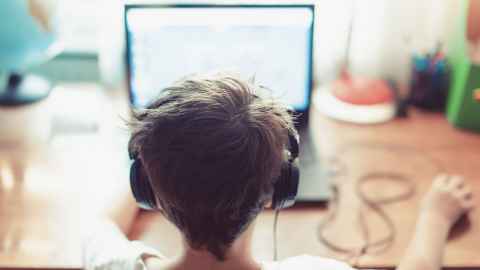Excessive screen-time bad for kids' health
15 April 2024
Children's excessive screentime is associated with multiple harms to health, mental health and cognition, a new study finds.

A new study is highlighting the risk of harm to the health and wellbeing of young people from the frequent and extended use of digital technologies.
Impact of digital technologies on health and wellbeing of children and adolescents: a Narrative Review, published in the New Zealand Journal of Physiotherapy, was led by former AUT student and paediatric physiotherapist Julie Cullen, who is now completing her research thesis at the University of Auckland. Fellow authors included Dr Alex Muntz and Dr Sam Marsh, both from the University of Auckland.
“While digital technologies certainly offer opportunities for learning and other benefits, frequent and extended device use is associated with risk of harm to child and adolescent health and wellbeing,” Cullen says.
An exact description for excessive screen use is difficult to pinpoint, Cullen says, however the majority of negative impacts in the review were found between two and six hours of daily usage.
While this variation is wide, when put in context with rates of screen use by young New Zealanders, the need for healthier screen behaviours becomes clearer.
OECD data in 2018 showed that youth in Aotearoa used digital devices 42 hours per week on average, compared to 35 hours globally. And studies have shown that children’s screen use has increased since then.
That comes amid a background of increasing use of digital technologies for children and adolescents at home and school, with policies and guidance unable to keep up with the speed of change and adoption in many countries.
New Zealand students have high use of screens in class compared to global norms, with students in Aotearoa amongst the world’s highest users of digital devices in school, and with the highest use of internet in class in the world.
Most countries (including wealthy countries) use digital devices to learn in class once or twice per week.
Meanwhile frequent screen use for learning has been associated with reduced educational outcomes, both in New Zealand and abroad.
While some may argue quality is more important than quantity when it comes to screen use, this review found more nuanced results.
“Time spent using digital technologies appears to affect some areas of health, including dry eye disease, myopia, noise-induced hearing loss via headphone or earbud use and pain syndromes,” she says.
“For issues such as these, what kids are doing on the screen doesn't make much difference. The impacts don’t really change based on whether a child is playing games, using social media or doing schoolwork.”
These risks have been established in several studies in recent years with now increasing support for action to lower the risks linked to the increased use of technology. However, screen time wasn’t always the most important issue.
"Conversely, the quality and type of screen media may have more impact than duration of use, in areas of health such as mental health, wellbeing and cognition, depending on the age and developmental stage of the child.”
The group found a narrative review with a systematic search strategy was the best approach to the work due to the breadth of this topic, while allowing the holistic overview necessary for decision-making.
“The point of difference in this paper was the holistic overview of impacts, including vision, hearing, obesity, pain, sleep, cognition, mental health, and social impacts, as well as the inclusion of evidence-based advice on how to reduce risks,” Cullen says.
Understanding the impacts and what can be done about it is particularly important, considering rates of screen use for children and youth in New Zealand.
The United Nations Educational Scientific and Cultural Organization (UNESCO) released a report in late 2023, noting excessive screen exposure through school use can contribute to exacerbation of overall health risks.
It has called for discussion and decision-making to support children’s access to safer, fairer and effective use of technology. However, that’s not easy in the current environment, the article notes.
“The challenge is that frequent, extended use of digital technologies has become commonplace as screens are used for recreation, school, and work,” Cullen says. “We have set out a number of pragmatic recommendations, developed by subject experts, for clinicians, educators, and parents.”
Recommendations include interventions to reduce risks such as taking eye breaks, blinking exercises, regular vision and hearing testing, advice on safer use of headphones and earbuds and ergonomic guidance.
“These can support our young people to access technologies and gain essential digital skills, while mitigating risk and encouraging safer screen behaviours in education and home settings,” Cullen concludes.
Media contact
FMHS media adviser Jodi Yeats
E: jodi.yeats@auckland.ac.nz
M: 027 202 6372